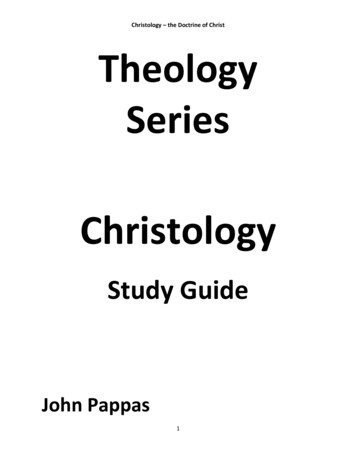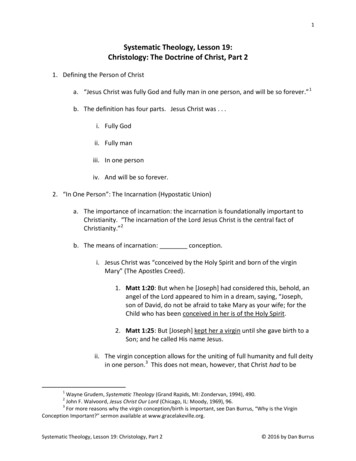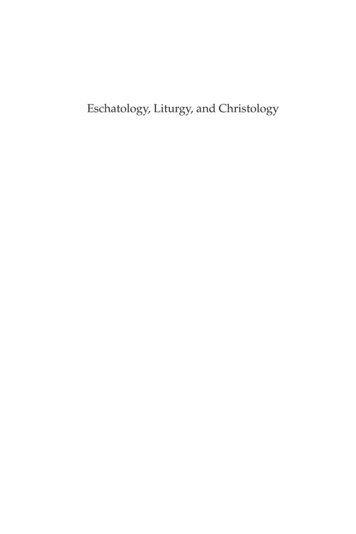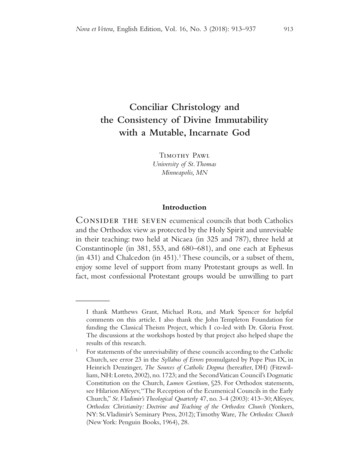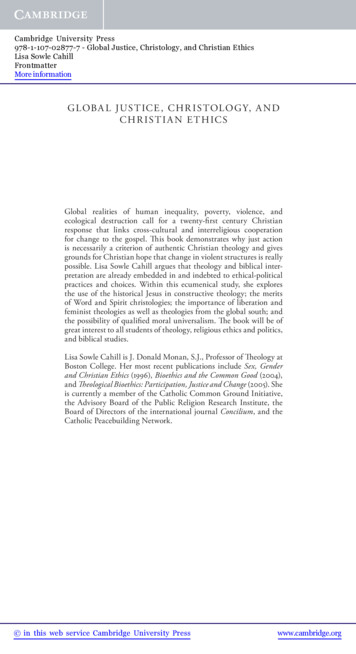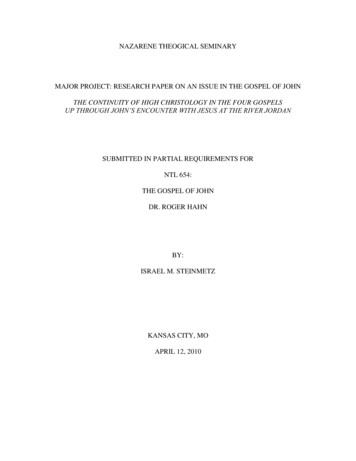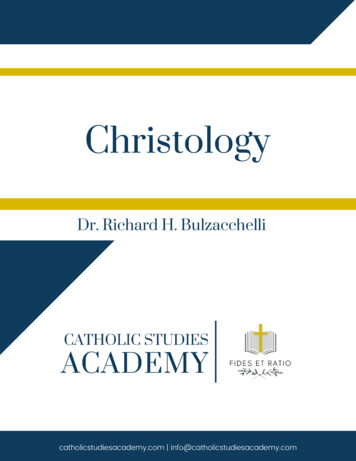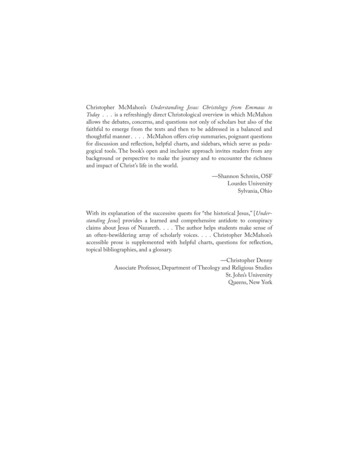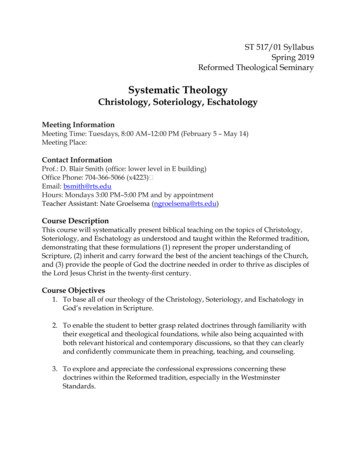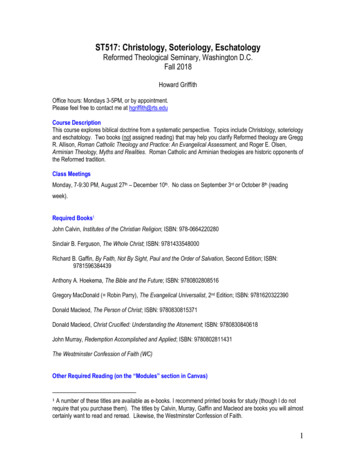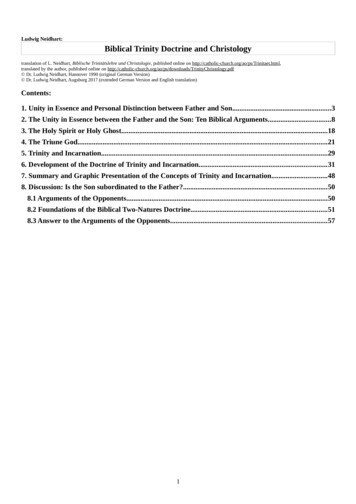
Transcription
Ludwig Neidhart:Biblical Trinity Doctrine and Christologytranslation of L. Neidhart, Biblische Trinitätslehre und Christologie, published online on anslated by the author, published online on Christology.pdf Dr. Ludwig Neidhart, Hannover 1990 (original German Version) Dr. Ludwig Neidhart, Augsburg 2017 (extended German Version and English translation)Contents:1. Unity in Essence and Personal Distinction between Father and Son.32. The Unity in Essence between the Father and the Son: Ten Biblical Arguments.83. The Holy Spirit or Holy Ghost.184. The Triune God.215. Trinity and Incarnation.296. Development of the Doctrine of Trinity and Incarnation.317. Summary and Graphic Presentation of the Concepts of Trinity and Incarnation.488. Discussion: Is the Son subordinated to the Father?.508.1 Arguments of the Opponents.508.2 Foundations of the Biblical Two-Natures Doctrine.518.3 Answer to the Arguments of the Opponents.571
Jesus Christ,1 after He was risen from the dead, commanded His disciples to baptize all nations into the name of ‘the Father andthe Son and the Holy Spirit’ (Mt 28:19).2 Here we are dealing with the deepest of all mysteries – with the inner life of God. Thedoctrine of the Trinity3 tries to answer the following questions: Why or in which sense is Christ called ‘the Son of God’4 and ‘theWord of God’5 in the Scriptures? Who or what is the Holy Spirit? Which relation holds between God the Father, the Son and theHoly Spirit? I am going to defend the classical Catholic answers to these questions provided by the Trinity Doctrine and the TwoNatures Doctrine,6 which found wide acceptance within Christianity, being opposed, however, by Unitarians of different kinds(Ebionites, Theodotians, Arians, Socinians, Christadelphians, Jehovah's Witnesses and Oneness Pentecostals, for example). Myargumentation is based mainly on the Scriptures of the Bible, 7 which has been correctly interpreted by the mainstream of Catholictradition (as I intend to show in the footnotes and in chapter 6). Additional philosophical reflections are used only to clarify certainaspects of the concept that is to be defended here as biblical.1 ‘Jesus’ (or more precise ‘Jesus of Nazareth’ is the name of the founder of Christianity who appeared roughly. 2000 years ago in Israel (for the meaning of thename see footnote 46); ‘Christ’ is the Greek translation of the Hebrew title ‘Messiah’ meaning ‘the anointed one’, referring to the eschatological Saviourannounced and expected by the Old Testament prophets. The title alludes to the dignity of the King, Priest and Prophet, because in the Old Testament times kings,priests and prophets have been anointed with oil at their inauguration into office (for further details about the expected Messiah see footnote 38). In the NewTestament, Jesus is seen as the expected Christ/Messiah (cf. Mt 16,16; John 4,25–26) and is addressed with this title 538 times; so the title ‘Christ’ occurs muchmore frequent as Jesus' designations as ‘Son of God’ (see footnote 4).2 The quotations from the Bible are my own translations of the original texts; the abbreviations used for the Biblical Scriptures are for the 46 Scriptures of the OldTestament Gen (Genesis), Ex (Exodus), Lev (Leviticus), Num (Numbers), Deut (Deuteronomium), Jos (Joshua), Judg (Judges), Rut, 1 Sam (1 Samuel), 2 Sam (2Samuel), 1 Kings, 2 Kings, 1 Chr (1 Chronicles), 2 Chr (2 Chronicles), Ezra, Neh (Nehemiah), Tob (Tobit), Jdt (Judith), Est (Esther), 1 Macc (1 Maccabees), 2Macc (2 Maccabees), Job, Ps (Psalms), Prov (Proverbs), Ecc (Ecclesiastes), Cant (Song of Solomon), Wis (Wisdom), Sir (Sirach), Isa (Isaiah), Jer (Jeremiah), Lam(Lamentations), Bar (Baruch), Ezek (Ezekiel), Dan (Daniel), Hos (Hosea), Joel, Am (Amos), Ob (Obadiah) Jon (Jonah), Mic (Micah), Nah (Nahum), Hab(Habakkuk), Zeph (Zephaniah), Hag (Haggai), Zech (Zechariah), Mal (Malachi), and for the 27 Scriptures of the New Testament Mt (Gospel of Matthew), Mk(Gospel of Mark), Lk (Gospel of Luke), John (Gospel of John), Acts (Acts of the Apostles), Rom (Romans), 1 Cor (1 Corinthians), 2 Cor (2 Corinthians), Gal(Galatians), Eph (Ephesians), Phil (Philippians), Col (Colossians), 1 Thess (1 Thessalonians), 2 Thess (2 Thesslonians), 1 Tim (1 Timothy), 2 Tim (2 Timothy), Tit(Titus), Phlm (Philemon), Heb (Hebrews), Jas (James), 1 Pet (1 Peter), 2 Pet (2 Peter), 1 John, 2 John, 3 John, Jude, Rev (Revelation).3 The Greek word for ‘Trinity’, i.e. Threeness (‘trias’) first occurs with respect to the Christian God in the writing To Autolycus of St. Theophilus of Antioch (written c. AD 180) in the phrase “Trinity of God and His Word and of His Wisdom” (Ad Autolycum 2,15), where ‘Word’ refers to the Son (cf. John 1), and ‘Wisdom’ tothe Holy Spirit (cf. John 14:25, although others have appropriated God's Wisdom to the Son, as St. Paul had done already in 1 Cor 1:24; for the so-called appropriations see p. 11 with footnote 40). A more detailed account of the Trinity Doctrine had already been presented some years earlier (c. 177) by the Christian philosopher Athenagoras of Athenes (see footnote 254). For sill earlier trinitarian expressions of Valentinus (fl. 140–160) and Basilides (c. 135) see footnotes 18 and 120.The earliest expressions, of course, are found in the Bible, as we shall see.The Latin word for ‘Trinity’ (‘trinitas’) was first used to describe the Christian God by the Christian lawyer Tertullian (* c. 160; † after 220) in his writingsAdversus Praxean (written c. 215 AD) and De pudicitia (written c. 218 AD). In De pudicitia (his last work), Tertullian speaks in chapter 2,16 of “the Trinity of theone Divinity, Father and Son and Holy Spirit”. In chapter 2,4 (cf. also 4,2) of Adversus Praxean, he explains his views, setting himself apart from Praxeas'modalistic Trinity concept (see footnote 128): “They [Father, Son and Holy Spirit] are of the one, namely by unity of the substance, while nonetheless is guardedthe mystery of that natural order [oikonomiae] which disposes the unity into a trinity [quae unitatem in trinitatem disponit], setting forth Father and Son and Spiritas three, three however not in quality [statu] but in sequence/grade/rank [gradu], not in substance but in form [forma], not in power but in manifestation [specie],yet of one substance and one quality and one power, seeing it is one God from whom those ranks and forms and manifestations are reckoned out in the name of theFather and the Son and the Holy Spirit.” In chapter 25,1, he adds: “qui tres unum sunt, non unus”, i.e. the three are ‘unum’ ( one and the same being, thing,substance or essence), but not ‘unus’ (one and the same person).As is well known, Tertullian left the Catholic Church and became member of the rigorist movement founded by the self-declared ‘prophet’ Montanus (which iswhy Tertullian isn't considered a saint; for Montanus cf. footnote 98), and his writings after 213 are from his ‘Montanist’ epoch. Moreover, some scholars haveclaimed that he was not quite orthodox in his views about Trinity, and the same accusation has been made for other (and virtually all) Christian theologians beforethe Council of Nicaea (AD 325), such as St. Ignatius of Antioch (c. † 108), St. Justin Martyr († 165), St. Irenaeus of Lyons († 202). But these Fathers seem to beplainly orthodox, if we carefully examine the content of their teaching, not the wording (for Ignatius, see footnote 214; for another precise Pre-Nicene explanationof the Trinity, that of Athenagoras, see footnote 254; for Pope St. Dionysius' equally exact account see footnote 128; for the alleged error of the Pre-Nicene Fatherscf. footnote 120), because the terminology has been refined in later centuries (cf. footnote 18). An interesting analogy for this phenomenon is the fact hat (as shownin footnote 65) the word ‘to adore’ (or the Latin equivalent ‘adorare’) is used today by ecclesiastical authorities as a ‘terminus technicus’ for absolute veneration,allowed to be offered only to God; whereas in earlier times (even in the Vulgate translation of the Bible) ‘adorare’ describes also acts of legitimate honor offered tohumans. But, of course, it would be an error to conclude that earlier theologians, because they used ‘adorare’ in a broader sense than we do today, had no orthodoxview in this matter. The same error is done, in my opinion, if one argues that Tertullian, because he speaks of ‘ranks’ in the Trinity, has a subordinatianist view (i.e.holding, that the Son is a God of ‘lower quality’ than the Father). For, Tertullian emphasizes explicitly in the above quotation, that the persons are not three ‘inquality’ [statu]; so the ‘rank’ or ‘sequence’ is to be interpreted in the orthodox sense of a natural order of honor (due to the eternal relations of origin) betweenessentially equal persons (see below pp. 8 and 25). And if in chapter 9,2 of Adversus Praxean Tertullian writes that “the Father is the entire substance, but the Sonis a derivation and portion of the whole, as He Himself acknowledges: My Father is greater than I” (cf. John 10:30), we should remember that in the later orthodoxTrinity Doctrine, too, the Son ‘derives’ His being from the Father; and while in orthodox terminology we do not say that He is a ‘part’ of the Father's substance, theFather still has not transmitted to the Son the attributes of ‘fatherhood’ and of ‘being unbegotten’, whence it would be right to say that the Son has inherited only apart of the Father's attributes. The view that the Father has a priority of honor within the Trinity is also orthodox; also some orthodox Post-Nicene Fathers referredChrist's statement John 10:30 (My Father is greater than I) to the Father's greater honor in the order of origin (see footnote 249). Thus, although Tertullian andother Pre-Nicene Fathers had not yet found in every instance the later sophisticated terminology, it is remarkable thought, that Tertullian was able to describe theTrinity in a very precise manner even with respect to terminology. For Tertullian, see further footnotes 6, 24, 25, 98, 128 and 157. Apart from theological writings,there are also some other impressive testimonies for the trinitarian faith of Christian communities in the first centuries, as for example the famous Vesper HymnPhos Hilaron, dating back probably to the 2 nd century: “Having come to the setting of the sun, and beholding the evening light, we sing in praise to the Father andthe Son and the Holy Spirit of God.” Here, the Trinity is just praised, without any theological sophistry.4 There are plenty of Scripture verses that ascribe to Jesus the title ‘Son of God’ in the New Testament, see Mt 2:15, 3:17, 4:3, 4:6, 8:29, 11:27, 14:33, 16:16, 17:5,21:37, 24:36, 26:63–64, 27:40, 27:43, 27:54, 28:19, Mk 1:1, 1:11, 3:11, 5:7, 9:7, 12:6, 13:32, 14:61–62, 15:39, Lk 1:32, 1:35, 3:22, 4:3, 4:9, 4:41, 8:28, 9:35,10:22, 20:13; 22:70; John 1:18 (version); 1:34; 1:49; 3:16–18; 3:35–36; 5:18–26; 6:40; 8:35–38; 10:36; 11:4; 11:27; 14:13; 17:1; 19:7; 20:31; Acts 8:37; 9:20,13:33, Rom 1:3, 1:9, 5:10, 8:3, 8:29, 8:32, 1 Cor 1:9, 2 Cor 1:19, 15:28, Gal 1:16, 2:20, 4:4, 4:6, Eph 4:13, Col 1:13, 1 Thess 1:10, Heb 1:2–8, 3:6, 4:14, 5:5, 5:8,6:6, 7:3, 7:28, 10:29, 2 Pet 1:17, 1 John 1:3, 1:7, 2:22–24, 3:8, 3:23, 4:9–10, 4:14–15, 5:5, 5:9–13, 5:20, 2 John 1:3, 1:9, Rev 2:18. In the Old Testament see 2 Sam7:14 (cf. Heb 1:5a), Ps 2:7,12 (cf. Heb 1:5b), Prov 30:4; Hos 11:1 (cf. Mt 2:15); as indirect testimonies also Isa 7:14, 9:6 –7, Dan 3:25, Mic 5:1–5. Additionally,2
1. Unity in Essence and Personal Distinction between Father and Son“I and the Father are one” says Christ (John 10:30). According to the Church Fathers the kind of unity meant in this sentence isnot only a unity of the will or of love, but a deeper kind of unity, namely the unity of essence: essential unity.This implies that almost everything the Father possesses, does and is, can be ascribed to Christ, the Son of God, as well. Forexample, we read in John 16:15 (cf. Mt 11:27, Lk 10:22, John 3:35, 5:26; 13:3, 17:10): “all things that the Father has are mine”(so Father and Son have a kind of ‘joint property’, and if ‘all things’ include the essence, this is also an immediate proof for a‘unity of essence’), and in John 5:19: whatever things the Father does, “these things also the Son does in like manner.” Therefore,for instance, (just as the Father) also the Son has created the world (Heb 1:10) and all things that are created (John 1:3; 1 Cor 8:6),and also the Son raises the dead and gives them life (John 5:21), while He has live in himself just as the Father has (John 5,26,which seems to imply equality in essence). Moreover, the Son (just like the Father) is almighty (cf. Mt 28:18 and John 3:35), Heknows everything (John 16:30; 21:17), He is above all (John 3:31, Rom 9:5,8 Eph 1:21, Col 2:10, Heb 1:4, 1 Pet 3:22) and iscalled ‘the true God’ (1 John 5:20). So the Son seems to resemble the Father in almost every aspect. However, there must beexceptions, that allow us to speak about two distinct persons. The Bible says nowhere, that the Father ‘is’ the Son, neither is itpossible to conceive that somebody is his own son. Moreover, Christ prayed to the Father, and this presupposes of course apersonal distinction between the two. So what is the difference between the Son and the Father? Of course, we have to say at leastthat the Father ‘generates’ the Son and not vice versa. According to a couple of Scripture verses (Ps 2:7; Acts 13:33; Heb 1:5; Heb5:5) the Father said to the Son: “today I have begotten you”. While these words may remind us to a temporal event, which can beseen as a birth of the Son (e.g. the terrestrial birth of Jesus 2000 years ago, or his resurrection, which can be seen as a kind ofrebirth and seems to be meant in Acts 13:33) these temporal ‘births’ are not the fundamental constitution of the Son, since the Sonaccording to John 17:5 (cf. John 1:1–18, 6:38,42, 8:58, 16:28, 17:24, Col 1:17; cf. also Ps 110:3, Prov 8:23–27, 30:4, Mic 5:1–5)existed before his terrestrial life and has been with the Father even before the world had been created. The primary and firstgeneration of the Son must, therefore, be a process ‘in eternity’ before and beyond cosmical time. This generation has to bedistinguished from a normal generation in two aspects. First of all, it is obviously not a corporal process (for God the Father, beinga mere spiritual entity, has no corporal body). Secondly, it seems not to be a process in time, where something moves or changesuntil it comes to an end. Such a process would be called a creation, which the Church distinguishes from the generation of the Sonin the Nicene Creed. As understood by the Church Fathers, the eternal generation of the Son can be described as a ‘timeless’ process that is going on from eternity to eternity (in the eternal ‘today’) without interruption, change or movement, being a statusrather than a process, in which the Son receives at every instant his whole essence from God the Father and is related to him as thepermanent source of his being (in an analogous manner also the created universe is permanently sustained into existence by God).As for the Scriptural base for asserting such a timeless generation, we will discuss this more accurately at the very end of thistreatise.9 According to what has been said so far, Father and Son could be two separated persons with equal characteristics, one ofthem giving life to the other. Symbolically we could compare the Father to a sun, whose rays come together to bring about anothersun resembling the first one, being a perfect image of it. The relation between the two could be named essential equality orequality of essence. But “I and the Father are one” (John 10:30) implies according to ecclesiastical understanding much more,namely essential unity or unity of essence, so that Father and Son have not (and are not) two equal essences, but have (and are)one and the same essence, that is one and the same Divine Nature, Substance and Being. I will defend this interpretation of John10:30 later (see first argument for the unity of essence). Here, I am concerned only with the concept and its possibility.So how is it possible that two distinct persons share one and the same essence? We have no clear biblical or official ecclesiasticalanswer, but there have been made various speculative efforts to provide an answer. In order to see that the concept is notcontradictory, any possible explanation will do. Therefore, I will give my own very short speculative explanation. In this (and anyother) explanation the crucial step is to spell out the difference between ‘person’ and ‘essence’.So what is a person? It is the contrary of a ‘thing’. Every substance (in the sense of an entity that is not merely an attribute of another entity; see below) is either a person or a thing. For example, humans are persons, not things; a stone is a thing, not a person.For persons we use the pronouns ‘I’, ‘you’, ‘he’, ‘she’ while for things we use the pronoun ‘it’. A person can act consciously andsome Scripture verses refer to other ‘children’ of God (angels as well as human daughters and sons; see footnote 29).5 John 1:1 (cf. 1:14), Rev 19:13, cf. also Quran 4:172. Being God's Word, He also “speaks the words of God” (John 3:34; cf. 8:26, 12:49, 14:24).6 The Two-Natures Doctrine, too, can be found in considerably clear expression already in Tertullian's work Adversus Praxean (see footnote 3), where he writes inchapter 27 about Jesus Christ, the Son of God: “But in truth we find him definitely explained as both God and man” (27,10), and: “We see two natures/states[duplicem statum], not mixed but joined together in one person [non confusum, sed coniunctum in una persona], God and man Jesus” (27,11). This doctrine can befound already hundred years before Tertullian, in the writings of St. Ignatius of Antioch (see footnote 214).7 According to Catholic Tradition (see the Catechism of the Catholic Church of 1992, § 120) the Bible includes 73 Holy Scriptures, of which 46 Pre-ChristianJewish Scriptures constitute the Old Testament (OT) and 27 Greek Christian Scriptures the New Testament (NT): see the list in footnote 2. This content wasdefined by decisions of Pope St. Damasus in 382 and Pope St. Innocent I. in 405, and most solemny by declarations of two ecumenical councils: of the Council ofFlorence in 1442 and of the Council of Trent in 1546; the wording of these and other ecclesiastical decisions can be found in the Enchiridion symbolorum definitionum et declarationum de rebus fidei et morum of Denzinger and Hünermann (Freiburg: Herder, 37 th edition 1992), abbreviated with ‘DH’; cf. in our case DH 179–180, 213, 1335, and 1502–1504. The Catholic OT include the 7 so-called ‘deuterocanonical’ Scriptures [viz. Tob, Jdt, 1 Macc, 2 Macc, Bar, Sir, Wis; and alsoGreek additions to Dan and Est], that are extant today in complete form only in a Greek translation, while of the remaining 39 Scriptures of the OT we havecomplete versions in the Hebrew and Aramaic original language. The deuterocanonical Scriptures (called ‘Apocrypha’ by the Protestants) have been removed fromthe Bible by Rabbinic Judaism in 90–100 AD, and likewise later by most Protestant Churches. However, in our argumentation the deuterocanonical Scriptures donot occur significantly, because the arguments are based mainly on the New Testament.8 For Rom 9:5 cf. footnote 42.9 See the answer to argument 14 in chapter 8.3.3
voluntarily, which things cannot do. A person can be the subject and origin of conscious acting, while a thing can be only theobject and goal of such acting, or can be used as a tool. The main property of a person seems to be, that a person has its own actingand being ‘in its own hands’, meaning that a person disposes and rules over itself. A thing doesn't rule over itself (at least not in thedescribed sense), but can be ‘in the hands’ of persons. So the main difference is: Persons are ordained to possess things as well asthemselves, while things are ordained to be in possessed by persons. To make this difference clear, one can envision a person ashaving arms grasping and encompassing itself, while things have no arms but are in the hands of persons. So we could say: Thecharacteristic of a person distinguishing it from things is a kind of ‘self-embracement’. Now we come to the concept of essence:What is meant by the ‘essence of a person’ in contradistinction to ‘the person itself’? One can view a person from two sides:1. Normally one sees a person as the subject (origin) of its self-ownership and self-embracement: as the owner of itself and assomeone who grasps and encompasses itself. This is the imagination of the ‘person itself’.2. On the other hand, one might see a person also as the object (the goal) of self-ownership and self-embracement: as possessionof itself and as something that is grasped and encompassed by itself. Seen in this perspective, the person is viewed as a thingthat is (so to speak) non-personal, and this is the ‘essence of the person’.Thus, ‘the person itself’ and ‘its essence’ stand opposite to each other like owner and his possession, whereby the essence is noouter, losable possession; it is the innermost possession of the owner, not separable from (but identical with) himself.The self-ownership or self-embracement of a person is a very mysterious reality: What is it that allows a person to be somehowrelated to itself? We don't know exactly. But we are aware of a plurality of different build-in features in our own person whichcontribute to our self-relation, the most important seem to be self-consciousness, self-knowledge and self-love. While thesefeatures are different to each other, ‘the person itself’ and ‘its essence’ are not two distinct entities (otherwise the person would notown itself by being owner of its essence); they are only two distinct ‘sides’ of one and the same entity. Now it seems to belogically possible at least, that a certain person has a plurality of build-in features A, B, and C, each of which is sufficient withoutthe others to enable the person to relate to itself, such that the self-ownership (or self-embracement) of that person would be overdetermined thrice. This is not the case for the features of self-consciousness, self-knowledge and self-love, for these abilities aredependent on each other10 and therefore come together to build only one personality. But in another person there may be featuresA, B, C as described, each of which is itself a bundle of self-consciousness, self-knowledge and self-love and thus a kind ofpersonality on His own, whereby the difference may be, for example, that in A dominates self-consciousness, in B self-knowledgeand in C self-love. And thus, it seems possible that in God we have three distinct features that somehow introduce three distinctforms of self-ownership (and accordingly three distinct personalities) within the one Divine Being. Admittedly we must aware,that if we use the above explanation of ‘person itself’ in contradistinction to the ‘essence of the person’, we would have to say thatGod is only one person. But if His self-ownership has distinct modes, each of which constitutes the self-ownership independentlyand sufficiently, then these distinct modes (or different manners, in which God encompass, possesses and is the one Divine Being)might constitute distinct personalities. Therefore, in order to introduce distinct Divine Persons, it seems that one has to define a‘Divine Person’ in an unusual special manner, namely:A Divine Person is God seen as subject of only one mode of His multiple self-embracement.If we accept this definition, there can be indeed a plurality of Divine Persons, having (and being) one and the same DivineEssence. Thus, Father and Son could be ‘two Divine Persons’, but ‘one and the same thing’ (i.e. viewed as essences, they are oneand the same). They constitute also ‘only one person’, if we understand ‘person’ in the usual sense of the word. But the distinctionbetween both is based in the manner, in which Father and Son encompass, possess and are the one Divine Being,In traditional Trinity Doctrine, one speaks not only of three Persons, called Father, Son and Holy Spirit, but also of three Hypostases, and three modes of Subsistence (or sometimes also three Subsistences) of the Father, the Son and the Holy Spirit. On theother hand, on says that there is only one Divine Essence (called Godhead), one Divine Nature and one Divine Substance. Theterms Essence, Nature and Substance are taken to be synonymous here, 11 although within the realm of creatures, they have slightlydifferent meanings: The (physical) essence of an entity is the sum of all its characteristics, that are necessary for its identity; 12while the (concrete) nature of an entity is the part of its physical essence that specifies its characteristic actions and operations. 13A (concrete) substance (derived from Latin sub under, and stare to stay) is defined to be an entity that is not an attribute‘attached to’, ‘inhering’ and therefore ‘dependent on’ another underlying entity (like the so-called accidents or accidental properties, e.g. colors, shapes, sizes of an entity, that determine its outer appearance or unfold its internal condition); thus, a substance isan entity that does not exist ‘in another’ but ‘in itself’, being an independent bearer that supports his own existence (standardexamples are minerals, plants, animals, humans, Angels, and God). A substance is recognized by us in most cases as an entity thathas an underlying reality ‘beneath’ (i.e. ‘hidden under’) its accidental visible appearance. So, if one considers an entity that is a10 Clearly, self-consciousness without any self-knowledge seems to be impossible and vice versa, and self-love presupposes self-knowledge. Probably, also selfknowledge presupposes self-love, for in order to come to know oneself, one must focus attention on oneself, i.e. ‘love’ oneself to a certain extent.11 The Fourth Ecumenical Council of the Lateran (see also footnote 175) declared in 1215: “there is only one true God, eternal and immeasurable, almighty,unchangeable, incomprehensible and ineffable, Father and Son and Holy Spirit: three Persons, but one Essence, Substance or Nature being simple in all respects[.]” (DH 800). The uniqueness and simplicity (undivided unity) of God has been solemnly stated again 1870 by the First Vatican Council (DH 3001–3002).12 Essence is derived from Latin ‘essentia’, is the abstraction term of ‘esse’ to be, and means that what the object really is. The Greek term for essence, ‘ousia’,has the same meaning, for it is derived from the Greek feminine participle ‘ousa’ of the word of ‘einai’ to be. It is used for ‘essence’ and for ‘substance’ as well(see footnote 18). One differentiates between the ‘physical essence’ which is the sum of all its characteristic (including the individual ones) and the ‘metaphysicalessence’ containing only the ‘underivable core characteristics’ which must be named in a precise definition of the object.13 Nature is derived from Latin ‘natura’, which is derived from Latin ‘natus’ to be born; the Greek word for nature is ‘physis’, which is derived from ‘phyo‘ toplant. Thus, the ‘nature’ of an entity means originally its impetus it has had since birth, by virtue of being planted. One differentiates between the ‘concrete nature’that exists in a concrete individual, and the ‘abstract nature’ of a species or genus, common to many individuals of that species.4
substance, then this entity usually includes some changing accidents and a hidden non-accidental part that remains unchanged,which can be described as the ‘bearer’ of the changing accidents. This underlying part of the entity is then called ‘the carriersubstance’ of the entity; this substance is a ‘substance in the stricter sense’, while the entity is a ‘substance in a broader sense’,consisting of its ‘carrier substance’ and its accidents. It is clear that in an ordinary created entity the nature is part of the essence,which in turn is a part of its (carrier) substance, which in turn is also a part of the whole entity. However in God, it is assumed thatHe is not a bearer of changing accidents, that He has no non-essential characteristics and has no ‘non-activated’ parts (but is ‘pureact’ as the Thomists have put it); if that is true, then it seems that indeed His Nature, His Essence and His Substance are identicalamong themselves and with the simple Divine Entity as a whole. In view of the meaning of ‘Essence’, ‘Nature’ and ‘Substance’one can say that the Divine Persons, being owners of one and the same Divine Nature, Essence and Substance, ‘dwell in’ one andthe same Divine Essence, ‘act through’ one and the same one Nature and ‘consist of’ one and the same Divine Substance.It remains to explain the terms ‘hypostasis’ and ‘subsistence’. Hypostasis is derived from Greek hypo underneath, and
Jesus Christ,1 after He was risen from the dead, commanded His disciples to baptize all nations into the name of ‘the Father and the Son and the Holy Spirit’ (Mt 28:19).2 Here we are dealing with the deepest of all mysteries – with the inner life of God. The doctrine of the Trinity3 tries to answer the following questions: Why or
